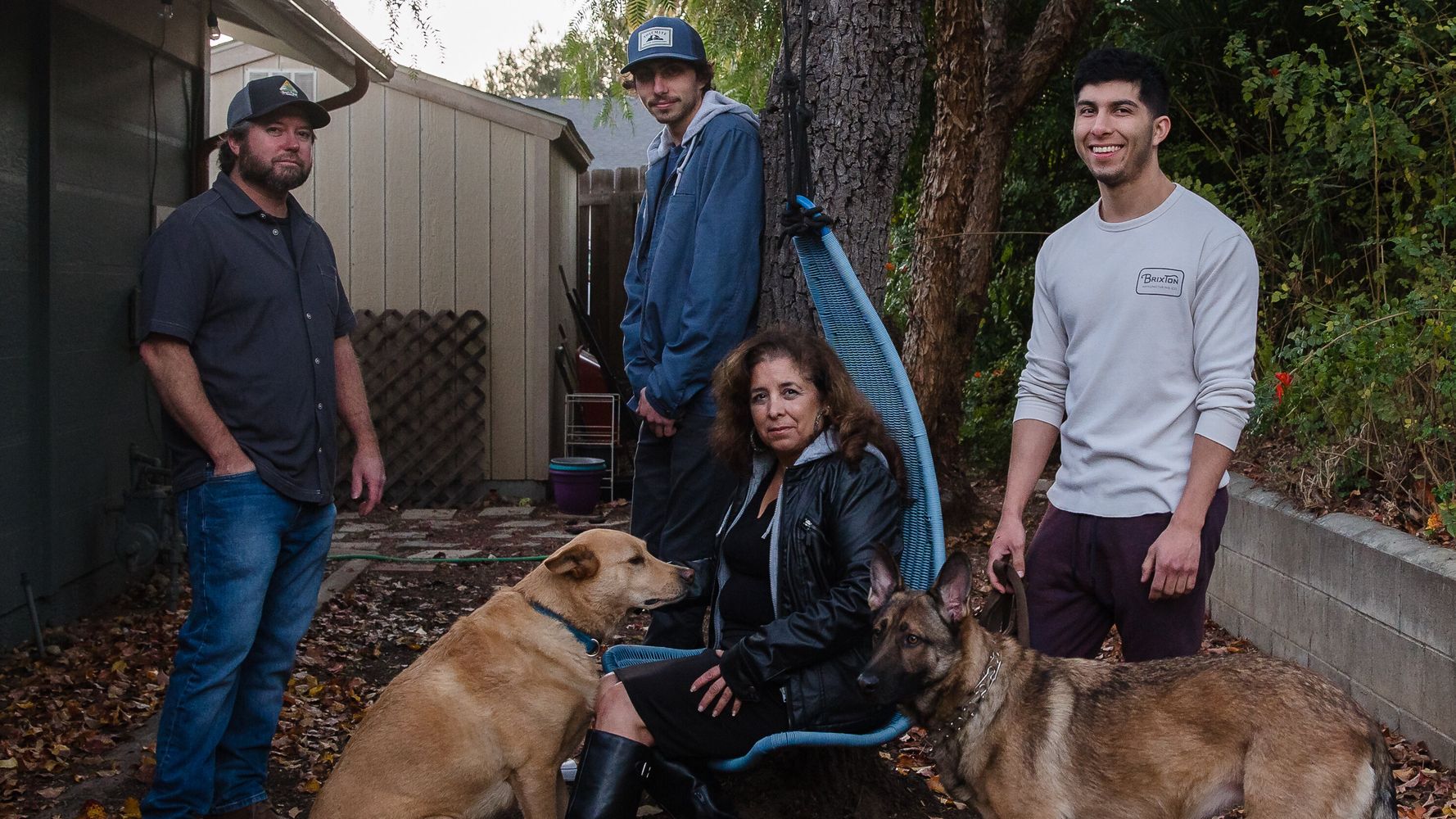Above: Ralphs employees Mike Kurtz, a meat manager (left); Joseph Salorio, a front-end manager; Raquel Salorio, a front-end manager; and Jack Dawe, a meat manager in the backyard of Joseph’s home in San Diego on Dec. 18. Credit: Ariana Drehsler for HuffPost
As coronavirus cases rose in San Diego this summer, Raquel Salorio took special precautions whenever she came home from her shift at a Ralphs grocery store. She left her shoes outside. She threw her clothes into the wash. She scrubbed her hands and hit the doorknobs with Lysol wipes. But she knew that her vigilance could only go so far.
After all, there were five grocery workers living in the same house, all coming and going from four Ralphs locations.
Her partner of three years, Mike Kurtz, is a Ralphs meat manager. Her son, Joseph, is a Ralphs front-end manager. Her daughter, Annalisa, is a Ralphs online order manager. And Annalisa’s boyfriend, Jack Dawe, is a Ralphs meat manager.
Earlier in the pandemic, they were collectively working about 250 hours per week at Ralphs, a subsidiary of grocery giant Kroger, serving hundreds of customers per day and then converging on the same living room, exhausted, wondering who might get sick. Their living situation is less strained now: Joseph, Annalisa and Jack recently decamped to a nearby house Joseph bought in late September. They are now two households of grocery workers, clocking in through the busy holiday season as coronavirus cases surge everywhere.
“It was very nerve-wracking, especially at the beginning,” said Kurtz, 47. “You’d come home every day looking at everybody else. ′How do you feel today? You OK?’”
The country’s more than 2 million grocery workers have carried a unique burden through the pandemic. The job typically does not pay very well, but it isn’t supposed to be dangerous. Workers have found themselves enforcing social-distancing rules and playing the role of mask police ― chores they never signed up to do. The hazardous conditions and huge grocery sales have taken a physical and mental toll. They’ve received a lot of thank-yous but not much in the way of hazard pay.
While no one among the five in the extended Salorio family has gotten the coronavirus, they have worked through fear and exhaustion for nine months, with many more to come. They are now heading into what’s usually the busiest grocery shopping stretch of the year.
“We’re pulling through, little by little,” said Raquel, 55.
Raquel has worked for Ralphs for 36 years. As a front-end manager, she oversees cashiers and customer service representatives and sometimes steps in to do those jobs. Usually she opens the store at 5 a.m., but ahead of the holidays she’s volunteered to fill in for someone else and stock shelves on the overnight shift, heading in at 1 a.m. and getting out around 10 a.m. She’s happy to encounter fewer customers for a while, even if it means more lifting.
“I’m a good worker, and they use me everywhere,” she said. “I like to do my thing and get it done with.”
One thing people underestimate about grocery work is how physical it is. Not just the bending and lifting, but also the miles of walking on cold, hard floors. Raquel’s legs ache after shifts. She wears good insoles, and Kurtz bought her a massager, but sometimes the pain is so intense that she sits in her car after work and gets tears in her eyes. But she said other essential workers, like hospital nurses and doctors, have it much harder right now.
“When I think about myself and feel bad for myself, I feel even worse for them,” she said. “They must see so much horror every day.”
Kurtz has typically been working 10-hour days, six days a week. Soon, due to the holiday crush, his shifts will stretch to 12 hours and maybe even 14 ― “dark-to-darks” as they call them in the winter months. His longest stretch of continuous workdays this year was 16. The overtime pay is nice, but the schedule leaves little time for family. He has three sons of his own, two of whom have been working at Costco stores during the pandemic.
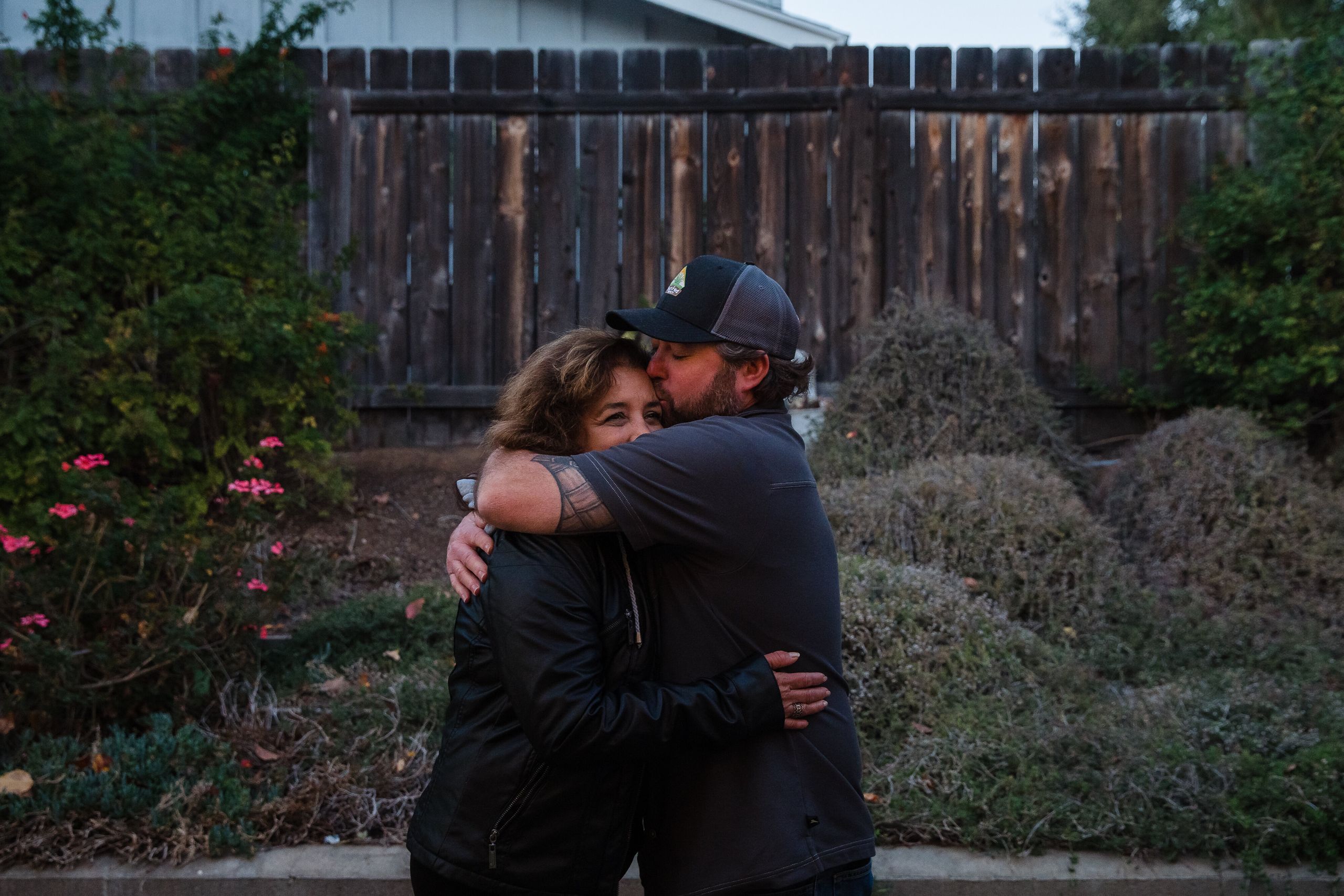
Long before they began to date, Raquel and Kurtz first met at a Ralphs store nearly three decades ago. “She probably don’t remember working with me,” Kurtz said. “I was a young man. She’s a couple years older than me. I remember her very well.”
Kurtz has worked at more than two dozen Ralphs locations over the years, and he eventually managed Raquel’s son, Joseph, who started working for Ralphs in high school. Joseph became a seafood manager when he turned 18. He has been with the company ever since.
Annalisa had worked at Ralphs since high school but didn’t plan to make a career of it. She graduated from cosmetology school in mid-March, just as the White House declared a national emergency due to the pandemic. Salons closed, and millions of service jobs vanished. She ended up staying with Ralphs, picking out items for online orders as many customers shifted to delivery and curbside pickup.
There’s still plenty of people inside the store, though, some of whom seem oblivious to social-distancing protocols. Kurtz and his colleagues have a running joke: “Come to the store. There’s no coronavirus here.” People crowd the meat case. They get in employees’ personal space. Sometimes it seems like families even make an outing of it just to get out of the house, since grocery stores are one of the few socially and legally acceptable indoor places to wander.
“They have nowhere else to go but to a grocery store,” Raquel said.
Customers have gotten much better about wearing masks, but she sometimes still encounters an attitude. On more than one occasion, female customers have apologized to her for the behavior of their husbands, including one who cursed at her when she asked him to pull his mask up so it covered his mouth rather than his chin. “I’ve worked six days for the last six weeks,” she recalled telling the woman. “I don’t need this from your husband.”
Most customers are kind and understanding, but Raquel feels as if she’s lost her usual connection to them. She’s the kind of person who walks into Target on her day off and finds herself greeting everyone she passes as if she were still at Ralphs. But now customers have trouble hearing her through the mask. She smiles by squinting her eyes.
“It’s kind of sad that that’s what we do now,” she said. “Before, we were programmed to say hi to everybody. Now they don’t want to look at you. On the front end, you barely say hi to anybody. It’s just a different job now.”
Different, and busier than ever. Joseph remembers sitting in a back room the day the national emergency was declared, and soon there were 300 customers swarming the store, with lines stretching deep into the aisles. Tensions ran high in those days, “people fighting over a parking spot, customers freaking out because a guy sneezed.” Most of Joseph’s friends lost their service-industry jobs. At 24, he found himself working 60-hour weeks, feeling responsible for the health and safety of dozens of employees, many of them twice his age.
There are customers who yell because a certain product is out of stock. He tells his colleagues not to focus on them: “They’re just scared, like us.” Instead, he says, “Look at all these other people thanking us.” People bring in pizzas and homemade cookies and masks. Elementary school kids make posters showing their gratitude. Customers ask workers if they can get them a cup of coffee from the in-store Starbucks, or they just hand them a gift card ― the kind of thing that never happened before the pandemic.
“Even a $10 gift card, it can go a long way,” he said.
Kurtz said he sensed that gratitude from customers particularly early in the crisis. But as the pandemic has worn on, it seems as though everyone has recalibrated their expectations.
“I guess I feel like there was a lot of appreciation for a time, but it definitely has worn off,” he said.
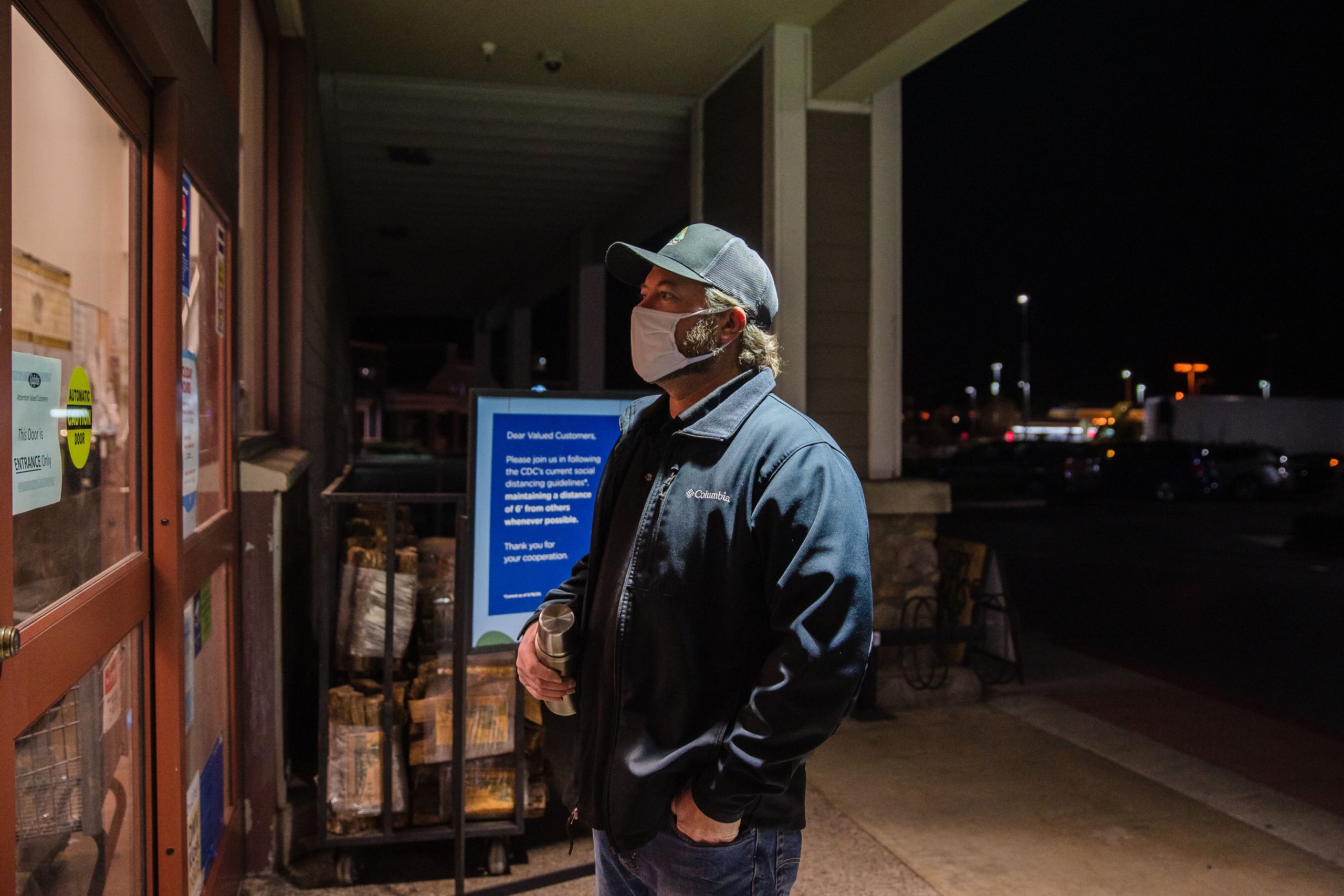
The work pace, however, has not let up much. Americans are doing nearly all of their eating at home, without office lunch breaks or meals out at restaurants. Although grocery sales have slowed compared with earlier in the pandemic, they remain higher than usual. Profits at the largest grocers were up 40% over 2019 as of last month, according to an analysis from the Brookings Institution.
Workers have received only a small share of that bonanza. Facing public pressure and fears of a worker shortage, a lot of companies instituted hazard pay in the spring. In most cases, it was an extra buck or two an hour, or a bonus, or a combination of both. Kroger gave its workers a temporary $2 raise and a pair of one-time bonuses.
The company called it “hero pay.” Raquel said her store even urged workers to dress up as heroes for a day, with capes and comic-book costumes, an ill-conceived morale booster she found in poor taste. She was relieved it fell on her day off. She still bristles at the idea. “We didn’t ask to be heroes, and we’re not heroes,” she said.
That modest pay increase ended for Kroger workers in May. The daily coronavirus case numbers in the U.S. have risen roughly tenfold since then. With a few exceptions, most other retailers have also scratched their pandemic pay boosts. But Kroger has been stingier than most, relative to the company’s windfall, said Molly Kinder, a Brookings fellow and co-author of the industry analysis.
Through three financial quarters of this year, Kroger nearly doubled its profits over the previous year, she noted, and the company authorized a $1 billion stock buyback program in September.
“Kroger really stands out. They’re spending more on stock buybacks than they are on any kind of hazard pay,” said Kinder. “These workers get it. They may not have the numbers in front of them, but they know what’s going on. They see that sales are through the roof.”
Kristal Howard, a Kroger spokesperson, said in an email that the company has spent $1.3 billion on employees during the pandemic. But that figure includes money devoted to in-store safety measures, not just hazard pay and bonuses. She also said Kroger has a $15 million fund to help employees struggling financially. ”We continue to listen to our associates and take steps to ensure their safety and well-being.”
Marc Perrone, president of the United Food and Commercial Workers union, which represents workers at Ralphs and other Kroger chains, said the company seems more concerned with its shareholders than its workers. He said some chains have continued their temporary pay increases while Kroger gave its employees $100 gift cards to spend at their own stores.
“They’re definitely behind the rest of the pack. Even the non-union operators are doing more than they’re doing,” Perrone said. “I’m just very disappointed in Kroger.”
The union says at least 109 grocery workers around the country have died of COVID-19, and estimates that at least 17,000 workers have been infected or exposed to the virus. Joseph recalls two coronavirus cases among workers at his store early in the pandemic.
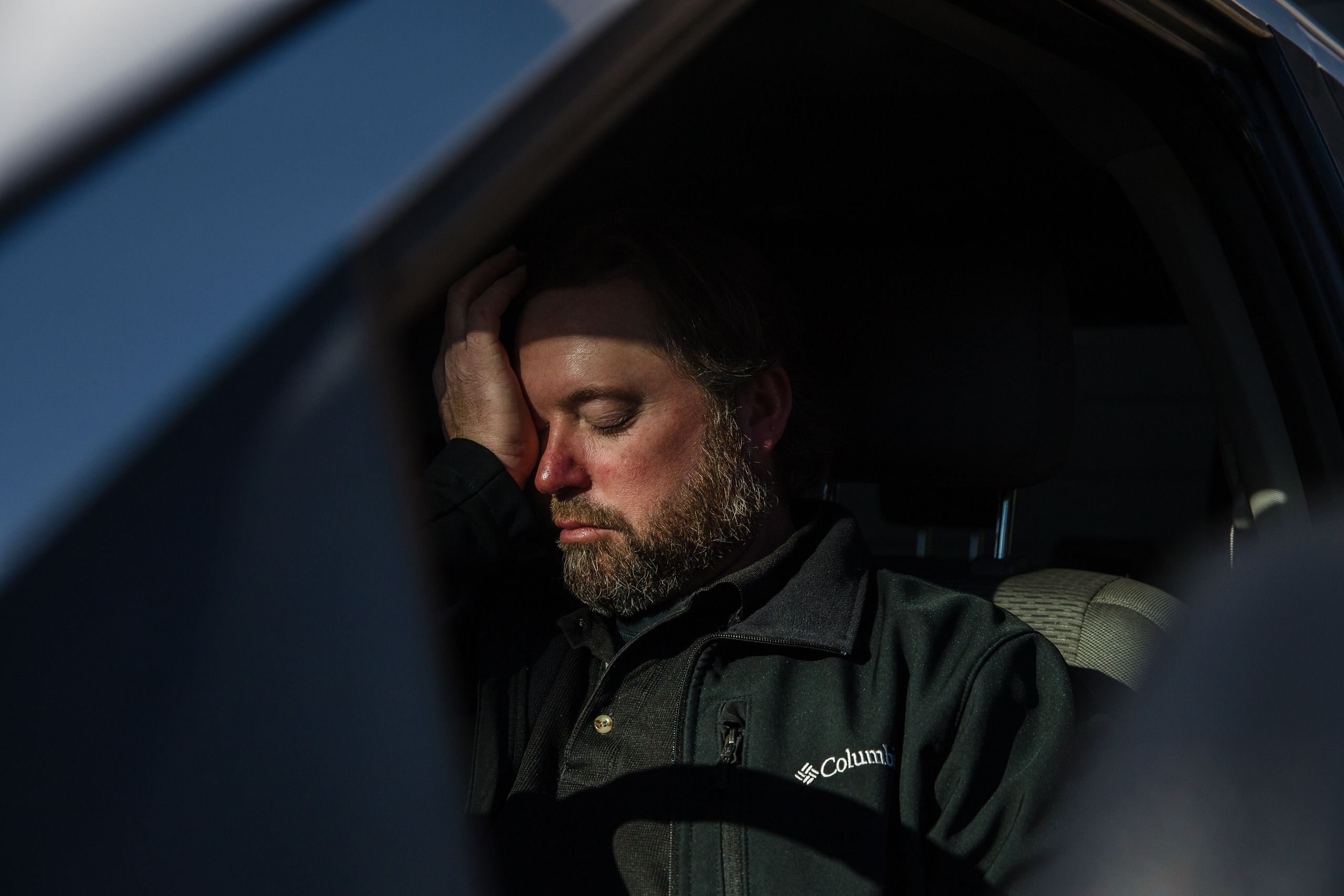
Kurtz wants hazard pay mostly for those who work under him. He has a lot of seniority and a higher wage. The extra $2 an hour would go further for those on the lower end of the scale, especially around the holidays, when everyone needs to buy gifts. “A lot of employees need it to survive,” he said. “They need it to get by and support their own families.”
Joseph said he feels the company has done a good job through the pandemic, especially when it comes to following the evolving local regulations on indoor capacity. Losing hazard pay was a bummer, but he said workers appreciated the Ralphs gift cards. He feels grateful to have a steady job with room to advance and enough income to become a homeowner.
“If I stayed where I’m at, I feel like I could have a comfortable life,” he said.
But his mother believes the job is not as good as it once was. When Raquel started working more than three decades ago, it seemed like an excellent living for not having a college degree. “It was a really good job in the beginning,” she said. “But now everyone has caught up or passed us.” She pays more for medical care and feels like the wages haven’t risen the way they should over the years.
They haven’t. Wages for grocery workers, like many blue-collar jobs, have barely risen since the late 1980s when adjusted for inflation. Meanwhile, grocery workers are taking home an increasingly smaller share of the pie. Compensation as a share of industry income has been headed downward since 2003, a trend that Labor Department economist Jenny Rudd attributes at least in part to industry consolidation as conglomerates like Kroger scoop up their competitors. (In addition to Ralphs, Kroger also owns Harris Teeter, Fred Meyer and more than a dozen other chains.)
At the same time, fewer grocery workers seem to be getting full-time work. The average hours worked each week dropped from 32 in 2003 to around 28 in 2018, a change Kurtz has watched unfold. “If they had it their way, everyone would be part-time employees and have four-hours shifts,” he said. “Without the union, it would be hard for these stores to get people to work for them.”
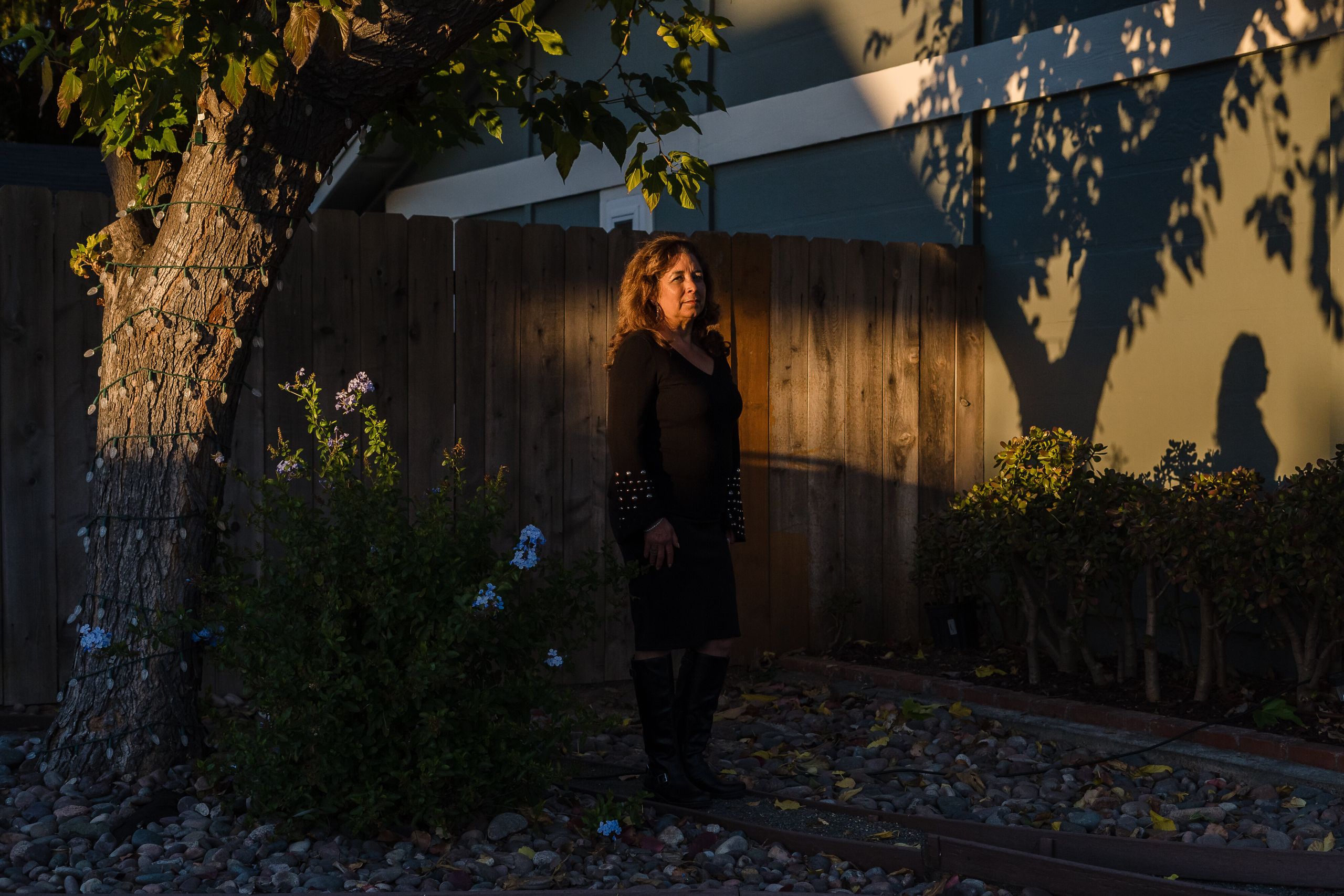
Kurtz and Raquel enjoy some better perks than the younger workers, since they were grandfathered in under older union contracts. They earn triple time for working a holiday like Christmas, whereas newer workers like Joseph get double pay. Joseph has volunteered to work a shift on Christmas at his mother’s store so that a front-end manager there can get the day off. He has a mortgage now, and he isn’t mingling with many people anyway.
“A lot of my friends ask me to hang out. I just let them know I’m really exhausted and deal with a lot of people, just in case there’s that chance I have [COVID-19] and I’m asymptomatic,” he explained.
Raquel usually works on Christmas. This year Kurtz urged her not to ― “very aggressively,” he explained ― and she turned down the extra shift. Kurtz is taking the holiday off as well. They won’t be seeing extended family due to the risks, but Kurtz might bring a prime rib home from the store for dinner.
They mostly just plan to spend the holiday resting, although not for too long. Raquel’s next shift starts at midnight.
A HuffPost Guide To Coronavirus
As COVID-19 cases rise, it’s more important than ever to remain connected and informed. Join the HuffPost community today. (It’s free!)
Calling all HuffPost superfans!
Sign up for membership to become a founding member and help shape HuffPost’s next chapter
